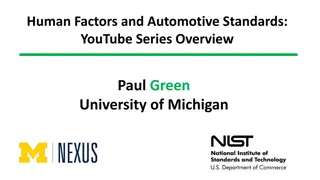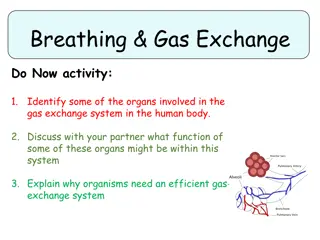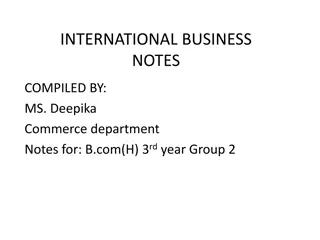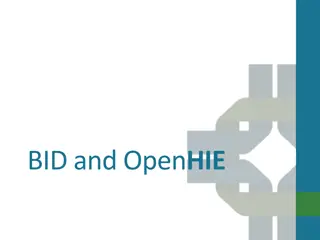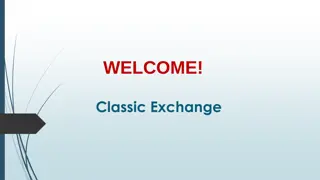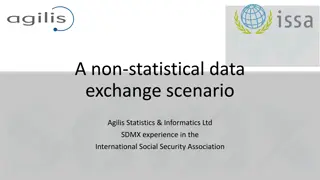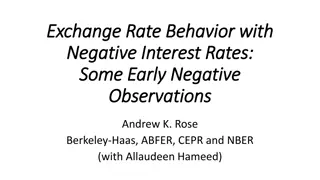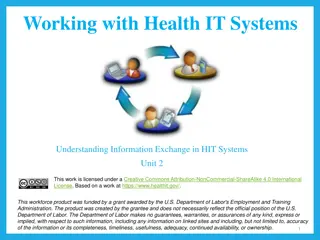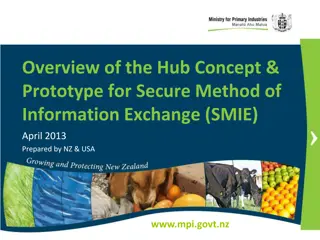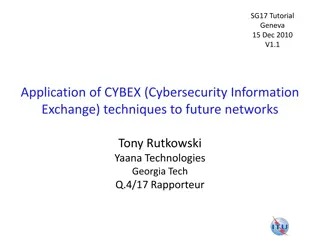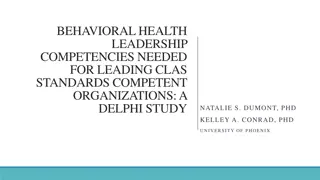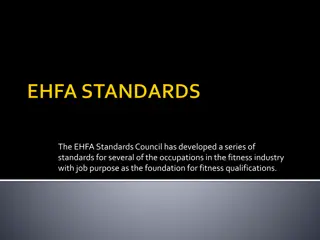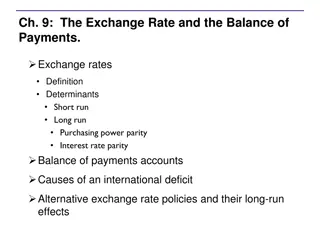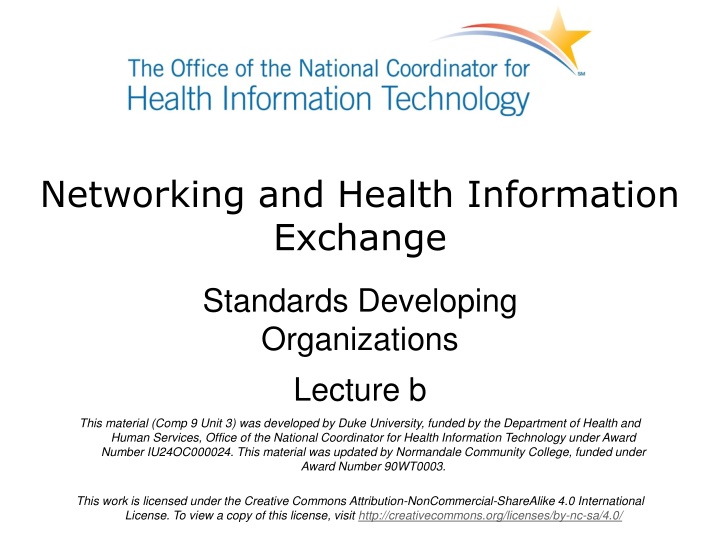
Standards Developing Organizations and Health Information Exchange
This material explores the standards developing organizations involved in networking and health information exchange. It covers the objectives, work groups, significant relationships, and harmonization efforts within the field. Learn about ISO TC 215, CEN TC 251, and other key entities shaping healthcare informatics standards.
Download Presentation

Please find below an Image/Link to download the presentation.
The content on the website is provided AS IS for your information and personal use only. It may not be sold, licensed, or shared on other websites without obtaining consent from the author. If you encounter any issues during the download, it is possible that the publisher has removed the file from their server.
You are allowed to download the files provided on this website for personal or commercial use, subject to the condition that they are used lawfully. All files are the property of their respective owners.
The content on the website is provided AS IS for your information and personal use only. It may not be sold, licensed, or shared on other websites without obtaining consent from the author.
E N D
Presentation Transcript
Networking and Health Information Exchange Standards Developing Organizations Lecture b This material (Comp 9 Unit 3) was developed by Duke University, funded by the Department of Health and Human Services, Office of the National Coordinator for Health Information Technology under Award Number IU24OC000024. This material was updated by Normandale Community College, funded under Award Number 90WT0003. This work is licensed under the Creative Commons Attribution-NonCommercial-ShareAlike 4.0 International License. To view a copy of this license, visit http://creativecommons.org/licenses/by-nc-sa/4.0/
Standards Developing Organizations Learning Objectives 1. Understand different kinds of standards being developed and for what purpose 2. Learn about Standards Developing Organizations and the standards they create 3. Demonstrate how to find, obtain, and use standards that are needed to facilitate networking and health information exchange 2
ISO TC 215 Healthcare Informatics Standards have national priority Members are nations Established in 1998 Products include Technical Reports, Technical Specifications, and International Standards 3
Work Groups of TC 215 WG1 Data Structure WG2 Data Interchange WG3 Semantic Content WG4 Security WG6 Pharmacy and Medicines Business WG7 Medical Devices WG8 Business requirements for Electronic Health Records WG9 SDO Harmonization 4
Significant Relationships Vienna Agreement HL7 Pilot Agreement IEEE Partnership Agreement 5
Harmonization of International Standards Creation of Joint Initiative Council in 2007 Founding members ISO TC 215 CEN TC 251 HL7 International Later members include CDISC IHTSDO GS1 Operates as a council of equals and was formed to create a single standard for a single business use 6
CEN TC 251 Workgroup within European Union Goal is to achieve compatibility and interoperability between independent systems and to enable modularity in EHR systems 7
CEN TC 251 Work Groups WG I Information Models WG II Terminology and knowledge representation WG III Safety and Quality WG IV Technology for Interoperability 8
CEN Standard EN 13606 An important CEN standard is EN 13606 Health Informatics Electronic Health Record communication, published in 5 parts 1. Reference Model 2. Archetypes interchange specification 3. Archetypes and term lists 4. Security 5. Interface specification These standards are being used in the European Union and are becoming ISO standards 9
Health Level 7 International Formed in 1987 as a U.S. SDO; invited international affiliates in the early 1990s Now HL7 International with over 40 international country members Is an ANSI accredited SDO 10
HL7 Steering Divisions Domain Experts Foundation and Technology Structure and Semantic Design Technical and Support Services 11
Domain Experts Anatomic Pathology Anesthesiology Attachments Child Health Clinical Interoperability Council Community Based Health Services Emergency Care Government Projects Health Care Devices Imaging Integration Laboratory Patient Care Patient Safety Public Health Emergency Response (PHER) Pharmacy Regulated Clinical Research Information Management (RCRIM) 12
Foundation and Technology Conformance & Implementation Infrastructure & Messaging Implementable Technology Specifications (ITS) Java Understand different kinds of standards being developed and for what purpose Learn about Standards Developing Organizations and the standards they create Demonstrate how to find, obtain, and use standards that are needed to facilitate networking and health information exchange 13
Structure and Semantic Design Arden Syntax Clinical Context Object Workgroup (CCOW) Clinical Decision Support Clinical Statement Electronic Health Record (EHR) Financial Management Genomics Orders & Observations Patient Administration Personnel Management Scheduling & Logistics Structured Documents 14
Technical and Support Services Education Electronic Services Implementation Marketing Committee 15
HL7 Products Messaging Standards Version 2.x (current is 2.7 published 12/07) XML Encoding Rules for v2 Messages Version 3.0 (2008 Normative Edition in publication) Infrastructure Master file structure infrastructure Role-Based Access Control 16
HL7 Products (2) Models Reference Information Model Data Types Common Message Element Type XML Implementation Technology Specification - Structures 17
HL7 Products (3) Application Electronic Health Record o Functional EHR-S Standard o Interactions for EHR-S and Functional PHR-S o Profiles EHR Behavioral Health Functional Model EHR Child Health Functional Model Scheduling Notifiable Condition Report Personnel Management Genomics - Pedigree 18
HL7 Products (4) Documents Clinical Document Architecture (CDA) Continuity of Care Document (CCD) Decision Support Arden Syntax Virtual Medical Record GELLO: Common Expression Language Infobutton 19
HL7 Products (5) Regulated Studies Structured Product Labeling (SPL) Annotated ECG Individual Case Safety Report (ICSR) Drug Stability Study Regulated Product Submission Common Product Model (CPM) Periodic Reporting of Clinical Trials Laboratory Results 20
HL7 Products (6) Clinical Context Object Workgroup (CCOW) Clinical Context Management Application Protection Package Manager Protection Package User Authenticator Package 21
Implementation Guides HL7 Claims Attachments Secure HL7 Transactions Using Internet Mail HL7 Security Service Framework CDA R2 Common Audit Message Standard Guide for Implementing HL7 EDI Communication Security HL7 Version 2.x Messaging Profiling Specification Continuity of Care Document (CCD) And growing 22
HL7 Standards Named in HHS Final Rule HL7 v2.5.1 Implementation Guide: Electronic Laboratory Results Reporting to Public Health Clinical Document Architecture (CDA) Continuity of Care Document (CCD) Messaging Standard v2.5.1 Messaging Standard v2.3.1 23
CDISC Standards Study Data Tabulation Model (SDTM) Recommended for FDA regulatory submissions Analysis Data Model (ADaM) Complements SDTM submission by detailing statistical analysis performed on clinical trials results Operational Data Model (ODM) Clinical Data Acquisition Standards Harmonization (CDASH) Laboratory Data Model (LAB) CDISC Terminology 24
GS1 Key Standards Barcodes eCom electronic business messaging standards for automatic transmission of data GDSN Global Data Synchronization allow business partners to have consistent item data in their systems at the same time EPCglobal use RFID technology to track items in real time 25
Standards Developing Organizations Summary- Lecture b Multiple SDOs = competing and overlapping standards Redundancy in work Redundancy in people Limited resources 26
Standards Developing Organizations References Lecture b References American Dental Association. (n.d.). Retrieved from American Dental Association website: www.ada.org ANSI - American National Standards Institute. (n.d.). Retrieved from www.ansi.org ANSI Accredited U.S. Technical Advisory Groups (TAGs) to ISO. (n.d.). Retrieved from www.ansi.org/standards_activities/iso_programs/tag_iso.aspx ASCX12 - About ASC X12. (n.d.). Retrieved from ASC X12 website: www.x12.org ASTM International - Welcome to ASTM.org. (n.d.). Retrieved from ASTM International website: www.astm.org CDISC Strength Through Collaboration. (n.d.). Retrieved from Clinical Data Interchange Standards Consortium website: www.cdisc.org DICOM (Digital Imaging and Communications in Medicine). (n.d.). Retrieved from Medical Imaging & Technology Alliance - a division of NEMA website: http://medical.nema.org/ GS1 The global language of business. (n.d.). Retrieved from www.gs1.org Health Level Seven International. (n.d.). Retrieved from HL7 website: www.hl7.org IEEE Advancing Technology for Humanity. (n.d.). Retrieved from IEEE website: www.IEEE.org IHE - Welcome to Integrating the Healthcare Enterprise. (n.d.). Retrieved from IHE International website: www.ihe.net Joint Initiative on SDO Global Health Informatics Standardization. (n.d.). Retrieved from Health Level Seven International website: www.jointinitiativecouncil.org/ 27
Standards Developing Organizations References Lecture b (2) References MedBiquitous Advancing Healthcare Education Through Collaboration. (n.d.). Retrieved from MedBiquitous Consortium website: www.medbiq.org National Council for Prescription Drug Programs. (n.d.). Retrieved from www.ncpdp.org National Institute of Standards and Technology. (n.d.). Retrieved from U.S. Department of Commerce website: www.nist.gov National Quality Forum. (n.d.). Retrieved from The National Quality Forum website: www.qualityforum.org OASIS - Advancing open standards for the information society. (n.d.). Retrieved from OASIS website: www.oasis- open.org OMG. (n.d.). Retrieved from Object Management Group, Inc. website: www.omg.org openEHR - Welcome to openEHR. (n.d.). Retrieved from openEHR website: www.openehr.org TC 215 Health Informatics. (n.d.). Retrieved from ISO (International Organization for Standardization) website: www.iso.org/iso/iso_technical_committee?commid=54960 Technical Committees, Workshops and other bodies. (n.d.). Retrieved from CEN (Comit Europ en de Normalisation) website: www.cen.eu/cen/Sectors/TechnicalCommitteesWorkshops/CENTechnicalCommittees/Pages/default.aspx?param= 6232&title=CEN/TC%20251 The Internet Engineering Task Force (IETF). (n.d.). Retrieved from Internet Society website: www.ietf.org U.S. National Library of Medicine - National Institutes of Health. (n.d.). Retrieved from U.S. National Library of Medicine website: www.nlm.nih.gov W3C. (n.d.). Retrieved, from W3C website: http://www.w3.org/ Welcome to IHTSDO. (n.d.). Retrieved from International Health Terminology Standards Development Organisation website: www.ihtsdo.org World Health Organization. (n.d.). Retrieved from WHO website: www.who.int 28
Standards Developing Organizations Lecture b This material was developed by Duke University, funded by the Department of Health and Human Services, Office of the National Coordinator for Health Information Technology under Award Number IU24OC000024. This material was updated by Normandale Community College, funded under Award Number 90WT0003. 29

